Microgreen knives can be confusing and hard to buy. In this article I break down my take on three of the most top reviewed microgreen knives on the market. With a breakdown on when microgreen knives should be bought as opposed to using cutting equipment you have already.
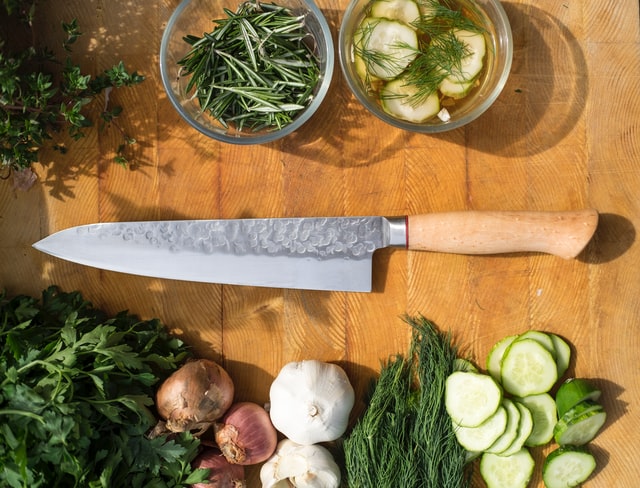
Table of Contents
- My comparison of the the best microgreen knives
- Mercer Culinary Millennia Green Handle Knife
- MAIRICO Ultra Sharp Premium 11-inch Knife
- SENBON Stainless Steel Ultra Sharp Pocket Knife
- Electric microgreen knife for microgreens
- Microgreen knife vs rolling macramé
- How to harvest microgreens with a knife
- Microgreen knife alternatives
- Pros and Cons of using microgreen knives
- Microgreen knife vs scissors
- Mistakes to avoid when buying microgreen knives
My comparison of the the best microgreen knives
When comparing microgreen knives I find it best to sit down and compare the best ones on the market overtime. I tried to give each one a fair test and chop up a range of vegetables and fruit as well as microgreens.
There isn’t much between them all but I will say some knives will suit different people based on what type of grower you are as well as the feeling you get holding it.
You can also use the same knives to chop normal vegetables grown from regular seeds as described
First up I tested the Mercer Culinary Millennia Green Handle Knife.
Mercer Culinary Millennia Green Handle Knife
This six inch knife is perhaps the most popular of microgreen knives there is. Many agree it is reliable and does the job, but where can it get better?
So like a lot of product reviews go, it starts with getting rid of way too much cardboard insulation in a box way too big for one knife. Amazon going overboard with the packaging as usual!
Then when I got to the packaging for the knife it was hard to get into due to the packaging being tamper proof. Fair enough, safety first.
So I spent a good five minutes fighting off the hard plastic before being greeted with the shiny blade of the Mercer.
I began by taking it out and giving it a clean. From first impression it seemed shorter than expected.
However it was clear the product was described as being only 6 inches long. That was a lapse in my judgement.
While my experience on microgreens isn’t vast, it was clear that harvesting a lot at once with this shorter knife would be a tedious task. But for the home grower with a pot or two of microgreens, no problem.
So first of all, it is clear this knife isn’t useful for large industrial scale.
Next, I gave it dishwasher test. From my experience of reviewing knives, the rubber on knives like these tend to wear away overtime. Nothing a single wash would be able to do. But any clear visibility changes should be noted.
And as I kind of expected there was no real change in the appearance of the rubber. However, if you want your knife to last for a really long time I’d recommend for good practice washing by hand.
This is also advised by the knife manufacturers both on the packaging and on the Amazon website. But it is nice to know if you accidentally slip it in the wash no real harm will be done.
So now the knife was definitely clean as I’d washed it twice, I chopped some broccoli on a standard chopping board and I noticed the handle of the knife really isn’t suited for this as shown. Despite it being great to grip.
This image shows what I mean, unless you chop your vegetables on the very edge of a table top, the blade will not be able to touch the end of the vegetable where it meets the table as the handle stops it from going all the way down.
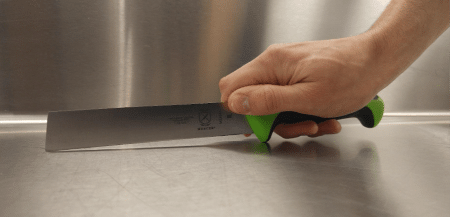
I guess this is where it is clear the knife was solely made specifically for microgreens and chopping in the air horizontally.
I will say though that the knife was extremely, extremely sharp. With very little force I was carving through vegetables with almost no resistance.
Coupled with the rubber grip whose shape seemed to be effortlessly moulded to my hand.
Finally, I tested cutting microgreens like the knife was intended for, the process was quite satisfying with how sharp it was and I even gave it a sharpen in-between rounds of chopping.
Sharpening only seems to make the knife sharper so there definitely wasn’t any chipping of the blade – we can conclude high quality steel is used in the knife.
One thing that struck me as quite appealing about the blade is that the tip of it is flattened so there isn’t the possibility of you accidentally poking or stabbing plants as you cut through them or worse yet, yourself!
Pros
- Excellent ergonomic grip with a rubber handle
- Definitely can survive dishwasher treatment
- Knife can easily be sharpened
- High quality steel
- Well designed for cutting microgreens
- Includes safety knife end to prevent stabbing
Cons
- May need to buy a sheath for the knife to prevent it from going blunt
- The 6 inch blade is not very long so is not be the quickest cutting knife
- Cannot double as a kitchen knife as the handle makes it impractical
The first thing that struck me about this knife is the packaging. It was excellent for any product of this budget.
It came in its own little magical looking box laid with cushioning with a business card. As I took it out I felt like I was holding a scared weapon or something along those lines.
I also loved the weight of the knife. At 11 inches long it was a heavier type of knife so I decided to test it straight away on some beef brisket.
Now I did read some reviews about the knife arriving dull and unusable so I was both sceptical and curious about trying it.
I was pleasantly surprised. The cut was clean, the no ripping of the meat and the knife felt sharp. What I like about it is the sheer length of the blade. I allows you to cut through in one swift movement rather than breaking up the flow of the cut.
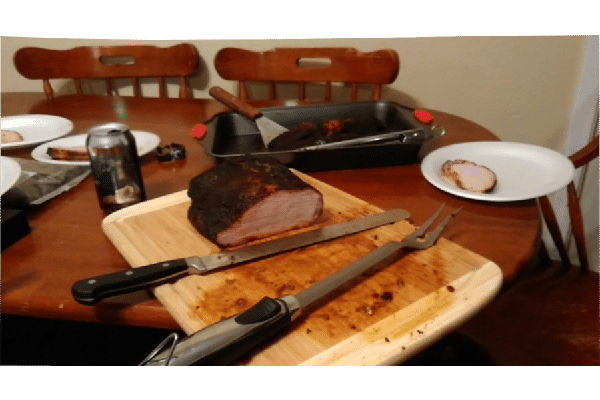
I imagined already that this would serve well for cutting microgreens at a larger scale.
Next I compared the feeling of cutting with this with one of my normal kitchen knives and it felt about the same in terms up sharpness but I definitely missed the extra length.
Maybe if you gave the knife a good sharpen before cutting it would beat most blades but the overall feeling wasn’t outstanding.
Finally came the most important test. The test on microgreens. For this cut, I got together my largest tray of greens to really allow the length of the knife to be highlighted.
As I had predicted from cutting my beef brisket earlier, the cut was smooth and efficient. However I do think the weight of the knife makes it slightly harder to handle when using it through the air horizontally as opposed to chopping something on a flat surface.
I preferred the feel of the Mercer millennia but the added length makes it that much more efficient so for larger harvests. This is probably the preferred knife for you. Despite the drop in ergonomic design.
Overall, I believe the knife looks a bit more expensive than it is as it is certainly well made. But as you get to use it the knife the sharpness isn’t outstanding and this brought the value of it closer to what I paid for it. But I’d still consider it a bargain.
I do also believe overtime the knife will lose its sharpness quicker than a higher quality steel from reading reviews and observing the manufacturing quality.
So perhaps a lower quality of steel was used, a reasonable hypothesis when you consider its price.
Pros
- Excellent feel with a comfortable weight
- Beautiful packaging
- Fast cutting speed for microgreens
- Can double as a kitchen knife quite easily
- Can be washed in a dishwasher
Cons
- Lower quality of steel used
- Knife has to be sharpened a lot
SENBON Stainless Steel Ultra Sharp Pocket Knife
For the final microgreen knife I tested, I went for the SENBON as review said it was a strong, well-built knife that also happened to be razor sharp.
Maybe this is because of the Chinese lettering on the packaging implying it came shipped from somewhere far away but I half expected this knife to need a good sharpening when it arrived but I was pleasantly surprised.
From just running my finger along the blade of the knife I could tell this was extremely sharp and the knife cut through the cilantro I had growing as microgreens with such ease.
Upon first inspection, I also noticed the metal seemed absolutely flawless with no imperfections, staining or kinks.
Again, much like the Mercer Culinary Millennia Green Handle Knife, this blade isn’t able to be put in the dishwasher nor is it very long. So I did have to cut through my microgreens with a good few cuts.
If I had to decide between this and the Mecer Millennia, I’d pick this one as it can double as a pretty cool kitchen knife but if I could only use the knife for microgreens the Mercer would be better.

Also despite the small size of the blade making it impractical for large scale use, I enjoy the look of it so much as smaller knife I may hang it up for display.
I didn’t do a dishwasher test on this knife as I really didn’t want to ruin the wood and I’d strictly advise against it so nothing to report there.
Overall, I enjoyed the feel of the knife a lot and the sharpness was definitely the best out of any of the knives on the list.
There was absolutely no tugging or excessive force being needed when cutting.
Something about this knife I really like despite it not being the most practical. It’s just all round a cool product and the feeling of the knife outweighs its disadvantages in my opinion.
Pros
- Excellent handle and feel despite the wooden grip
- Aesthetically pleasing
- Perfect for display
- Very sharp
- Can be used for other activities
Cons
- Small so can’t be used on a large scale
- Cannot wash in a dishwasher
Electric microgreen knife for microgreens
There aren’t really electric microgreen knives but you can use technology to cut your microgreens quicker or with less effort.
One of the bits of technology you can use is the quick cut greens harvester.
Quick cut greens harvester
Some people also refer to the product as a rolling Macramé. A macramé is string knotted in a pattern decoratively and these lines of string roll around and harvest microgreens as they knock into the leaves.
The product is ideal for bigger leaved microgreens such as cabbage or radish. The ropes of the machine roll around and push the leaves into the blade of harvester.
This makes the machine far more efficient than using a knife and saving time over large areas.
Also, the uniformity of a machine means that microgreens will be cut at a uniform length throughout the harvest.
Perfect for if you are looking to sell you microgreens and want more of an accurate cut or want to harvest your seeds carefully so you can soak, plant, grow and harvest your seeds all over again.
To get the most out of the machine it is best to use it when there are rows of microgreens available to harvest, not just a single tray.
What happens is you can keep the machine rolling over a large distance without stopping. Just like in the video.
Hamilton Beed Electric Microgreen Knife
Sometimes, microgreens can get extremely thick at the roots or you may be growing a variety that gets thicker stems. This is where using an electric carving knife is very useful.
Alternatively, if you want to achieve a uniform cut and know you have particularly shaky hands this could be a good alternative.
To use a knife like this I would angle the microgreen tray with your microgreens over a bucket or bin to collect the plant.
With a free hand use your tool to shave over the microgreen stems with the power on. Much like you would with a normal knife but without the slicing motion you would need.
Microgreen knife vs rolling macramé
The rolling macramé is a fairly big and expensive machine used to harvest microgreens that is not entirely necessary. However, at what point should you buy it and stop just using a knife?
Even if you can afford the machine, if you don’t have rows and rows of microgreens growing, then you’re better off using a knife.
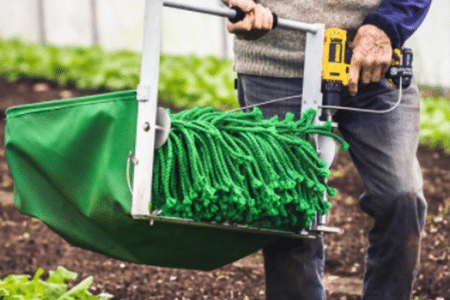
Especially if you do not have the clearance to put the machine on top of your trays as you harvest. Using this machine in a growing station where there are shelves of microgreens full of unstable trays wouldn’t work.
The main advantages of the rolling macramé would be that it is faster and cut the greens uniformly but it will come at quite a cost.
How to harvest microgreens with a knife
Harvesting microgreens with a knife is a straight forward process but there are a few technicalities we have to worry about. Especially when it comes to hygiene.
First of all, gather a microgreen knife and have some running water at hand and of course make sure you have your microgreens. If you are containing your microgreens have containers at the ready and make sure you have enough space to store them.
There is nothing worse than harvesting too many microgreens at once and not being able to consume or sell your microgreens in time. Leading to them being thrown away or composted.
Planning is key when harvesting.
For the next step you may also choose to wash your hands or wear gloves. Either way. Handling your microgreens with sterile hands is important to not only improve the life of your plants but also to remain professional – especially if you are trying to sell or distribute your harvest.
Position the tray of your microgreens at waist level or higher. You don’t want to be bending down as you want to keep your knife blade parallel to the soil for an even cut throughout.
Cutting from below or from above just makes it that bit harder to ensure you don’t poke the soil with your knife.
Next grab a handful of microgreens and at about half an inch above the soil and depending on the microgreen, cut through the microgreen stems.
I like to use a few long sweeping motions. It is important to have a very sharp knife and use a cutting movement rather than a stabbing movement.
Do not worry if you cut off some microgreens you are not currently holding as it is easy to pick them up later.
Instead, you should be checking for any dirt on the base of the plants to pick off. You may find that if you pulled your plant out of the soil rather than cutting them by accident. You will bring up some roots and some dirt.
Repeat this process while keeping your knife clean between cuts. This is important as you don’t want to distribute dirt from one cut to the next.
Microgreen knife alternatives
Some alternatives to cutting microgreens include using:
- Scissors
- Electric microgreen knives
- Macramé roller
- Kitchen knives
- Shears
Pros and Cons of using microgreen knives
Should you even buy a microgreen knife at all? If you are wondering if it will be worth the money or why you can’t just use some tools you have available already, here are some pros and cons.
Microgreen knives are certainly not necessary but help a lot in the process of harvesting.
Pros
- Sharp knives create a clean , professional cut
- Cuts through microgreens quickly
- Sharp knives prevent browning of microgreen stems after cut
- Mercer microgreen knife is safer than a kitchen knife
Cons
- You will have to buy a microgreen knife if you don’t already have one
- It is easier to be inaccurate when cutting when compared to scissors for example
- More dangerous to other methods like using scissors
Microgreen knife vs scissors
Microgreen knives generally are sharper and quicker for cutting. Any professional microgreen grower will likely use one.
That’s not to say scissors don’t have their uses.
I find scissors excellent for those who have a shaky wrist or are trying to cut microgreens for a first time. They allow you to line up your cut a lot better and give you greater precision.
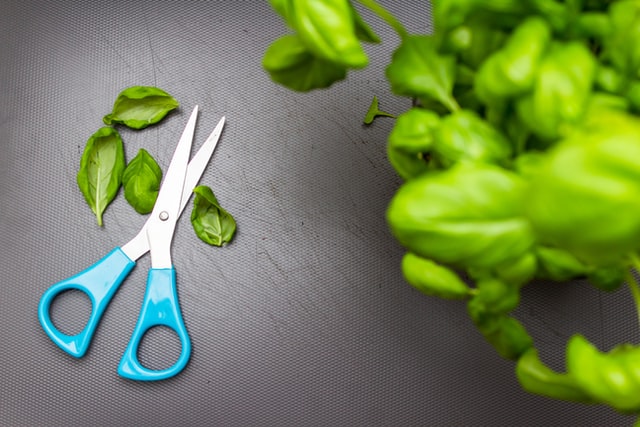
Perfect for if you were to introduce the process of cutting microgreens to children or looking to carefully collect your seeds so you can soak, plant and grow them again.
Also, scissors are considerably safer than knives, Even if you were to accidentally cut yourself with a scissors, injuries will generally be a lot less severe.
Having said that, you can reduce the risk of using a knife by using precautions like cutting away from you, wearing safety gloves and buying safer microgreen knives to begin with
To conclude, microgreen knives are preferred but don’t shy away from using scissors if there is a need to. Especially when cutting more delicate microgreens like cilantro for example.
Mistakes to avoid when buying microgreen knives
- Buying a kitchen knife
- Not having a knife sharpener for when it goes blunt
- Going too cheap and buy low quality steel
- Not checking product reviews








